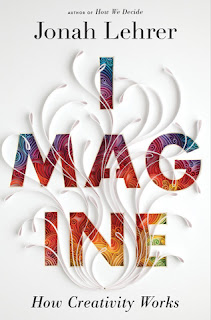Most people think creativity is something you are born with - you either have it or your don't. I would argue that creativity is a skill most people had a child before school taught them that they had to color within the lines and circle the one and only right answer for each question. The good news is: if you had it and lost then there is no reason you can't get it back again! That is why I love really good books on creativity. They can remind us what habits will help cultivate our creativity.
I thought Jonah Lehrer did an excellent job with Imagine. This book made me want to immediately relocate my office to a bustling city, spend more time letting my mind wander in early morning drowsiness, establish more interactions with divergent people throughout my day and completely rethink how I structure brainstorming sessions at work just to be able to spark more of those fabulous remote associations that lead to creative epiphanies that will become elegant solutions to work projects!
Below are some of the key take-aways I got from Imagine.
Book Notes:
- Happiness promotes creativity.
- Early morning drowsiness is a great time for insights. Get up 10 minutes earlier to allow time to linger in that drowsy state before you get up and fully engaged.
- Day dreaming is associated with creativity - along as you don't get so lost in the day dream you don't take notice when the insight comes.
- Direct personal interaction is important!
- Increasing the number of office interactions/conversations will increase insights.
- Set up teams to have to physically interact - Seating the cross functional teams in close proximity will increase creativity because it increases the "coffee room chats". Put the bathroom, break rooms etc in the middle so people have to bump into each other.
- Typical brainstorming sessions where "there are no bad ideas" are not effective. You need that feedback loop about what doesn't work so well about a proposed idea so that people can add on and build until it becomes a great idea. (Pixar's idea of "plussing")
- Bigger cities (with the right rules) foster more creativity and productivity because people have to interact with each other more.
- Creativity doesn't flourish in isolation. You need more loose associations rather than a few close ties to increase productivity. The popular idea of the lone creative genius is more fiction than fact.
- Business people who cultivated large diverse social networks (lots of diverse weak ties) are much more creative and productive than people who socialize with a smaller close group of colleagues.
- Business should encourage interaction, dissent, conversation and social networks to most creative thinking and productivity.
- You want to create a multiplier culture.
- One of the brute realities of the creative process is that creativity is work! You have to stick with it and work hard to be creative. The single best predictor of success - grit!
I got a lot of fantastic ideas from this book for stepping up creativity on my team. A few of them are easy like starting each big meeting with a funny video to spark creative thinking. A few of them may take a little more effort to implement like wanting to relocate the bathrooms and break room to promote interaction. (Yes, the facilities manager is going to get a good chuckle over that one.)
I recommend Imagine if you are looking to jumpstart creativity for yourself or your team.

No comments:
Post a Comment